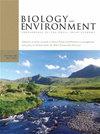用两种独立的方法重建湖泊的长期营养历史:动态计算机模型和古湖泊学在爱尔兰面罩湖的应用
IF 0.6
4区 环境科学与生态学
Q4 ENVIRONMENTAL SCIENCES
Biology and Environment-Proceedings of the Royal Irish Academy
Pub Date : 2022-01-01
DOI:10.3318/BIOE.2015.18
引用次数: 3
摘要
摘要:了解人类活动已经和正在超过自然变率的程度,可以为受影响水体的有效管理及其恢复做出重要贡献。然而,往往没有必要的监测数据,特别是在人为影响之前的时期,或者质量不足。通常提出两种方法来解决这个问题,这两种方法都涉及通过间接手段重建水质和相关生态条件的过去变化:计算机(后测)模型和沉积(古湖泊)分析。然而,这两种提出的解决方案并非没有各自的挑战。本文采用一系列动态计算机模型(集水区模型和湖内生态响应模型)和古湖泊学技术(包括基于沉积物的硅藻推断的总磷,DI-TP),重建了1905-2006年期间梅奥郡面罩湖(Lough Mask, Co. Mayo)的总磷浓度和初级生产力。尽管两种方法的结果显示了20世纪湖泊中养分富集的相似模式,但基于沉积物的DI-TP值始终高于后播模型的湖内TP浓度。这两种方法都表明,在c.公元1950年之前,蒙克湖的营养状况是少营养到中营养的。从公元1970年开始,营养条件明显升高(在中营养化-富营养化范围内)。模拟结果表明,从公元1970年开始,农业来源的扩散磷负荷增加是养分富集的主要驱动因素。富营养化与气候变暖同时发生,在模式模拟中表现为热分层强化。两种方法得出的结果表明,1950年前的营养状况可以作为参考基线,代表农业集约化产生重大影响之前的状况,以确定当前的水质管理目标。本文章由计算机程序翻译,如有差异,请以英文原文为准。
Reconstructing long-term trophic histories for lakes using two independent approaches: Application of dynamic computer modelling and palaeolimnology to Lough Mask, Ireland
Abstract:ABSTRACTAn understanding of the extent to which natural variability has been and is being exceeded by the effects of human activity can make an important contribution to the effective management of impacted water bodies, including their restoration. Frequently, however, the required monitoring data are not available, particularly for the period prior to human impact, or are of insufficient quality. Two methodological solutions to this problem are often proposed, both of which involve the reconstruction of past variations in water quality and associated ecological conditions through indirect means: computer (hindcast) modelling and sedimentary (palaeolimnological) analyses. Both proposed solutions are not without their own challenges, however. Here a series of dynamic computer models (a catchment model and an in-lake ecological response model) and palaeolimnological techniques (including sediment-based diatom-inferred total phosphorus, DI-TP), were used to reconstruct total phosphorus (TP) concentrations and measures of primary productivity in Lough Mask, Co. Mayo, for the period ad 1905–2006. Although results from both approaches indicated similar patterns of nutrient enrichment in the lake during the twentieth century, sediment-based DI-TP values were consistently higher than hindcast-modelled in-lake TP concentrations. Both approaches indicated oligotrophic to mesotrophic conditions in Lough Mask prior to c. ad 1950. Elevated trophic conditions (in the range mesotrophic–eutrophic) were evident from c. ad 1970. Modelling results indicated that increased diffuse phosphorus loading from agricultural sources was the main driver of nutrient enrichment from c. ad 1970. Eutrophication was also concurrent with climatic warming, which was manifested in strengthened thermal stratification in model simulations. Results generated by the two approaches suggest that pre-ad 1950 trophic conditions could be used as a reference baseline, representing conditions prior to major impacts from agricultural intensification, for defining current water quality management targets.
求助全文
通过发布文献求助,成功后即可免费获取论文全文。
去求助
来源期刊
CiteScore
1.10
自引率
0.00%
发文量
6
审稿时长
>36 weeks
期刊介绍:
The journal aims to offer a broad coverage of the subject area, including the following:
- biology and ecology of the Irish flora and fauna
- microbial ecology
- animal, plant and environmental physiology
- global change
- palaeoecology and palaeoclimatology
- population biology; conservation of genetic resources
- pollution and environmental quality; ecotoxicology
- environmental management
- hydrology
- land use, agriculture, soils and environment.
Submissions on other relevant topics are also welcome, and papers of a cross-disciplinary nature are particularly encouraged.

 求助内容:
求助内容: 应助结果提醒方式:
应助结果提醒方式:


